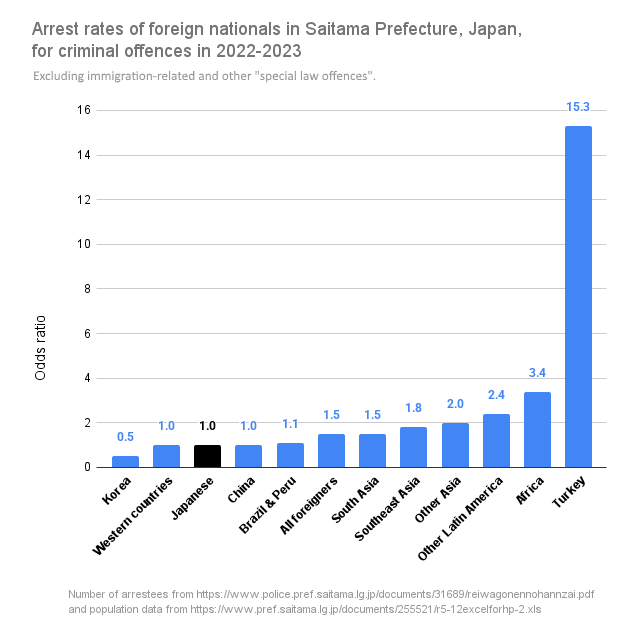Race and crime in Japan
Are the Japanese better at 'integrating' immigrants?
(Guest post by anon.)
Many are aware of disparities in crime rates among ethnic and racial groups in Western countries. But what patterns emerge in Japan, a country far from the Western world with a distinct history of immigration? Japan has a small immigrant population—only 2.8% of its residents were foreigners (foreign citizens) in 2024, primarily from East Asian countries, though smaller numbers hail from other regions.
Saitama Prefecture, near Tokyo, has over 7 million residents, of which more than 230,000 are foreigners (about 3%). Arrest statistics from Saitama allow for the calculation of crime rates by nationality. Data on arrests of foreign nationals for 2022–2023 are available here (pages 26 & 38) and population data for foreign nationals for the same years can be found here. Below is a summary of arrest rates relative to 1.0 for Japanese nationals. To ensure reliable results, smaller groups numbering only a few thousand (or fewer) are aggregated into broader categories (e.g. "South Asia," "Africa", etc.). An exception is made for Turkish nationals, largely Kurds, who number around 2,000. Since attention has been brought to this community in Japan recently, their crime rate is of interest as well.
Focusing on criminal offenses (excluding immigration violations and other "special law offenses"), Turkish nationals have the highest arrest rate, with a 15-fold overrepresentation over Japanese nationals (meaning they are 15 times more likely than Japanese to be arrested for crimes). Africans follow with an odds ratio of 3.4, then Latin Americans (excluding Brazilian and Peruvian nationals) at 2.4. Southeast Asians and South Asians also show elevated rates, at 1.8 and 1.5, respectively. Those from Brazil and Peru are largely descendants of early 20th-century Japanese emigrants and are mostly ethnically Japanese. Many of them have returned to Japan as foreign workers in recent decades, after one or two generations in South America. Their arrest rate is nearly identical to that of the general Japanese population. Chinese, "Westerners" (from Europe, the USA, Canada, and Oceania), and Koreans have arrest rates similar to or lower than Japanese nationals (Koreans ranking lower).
It should be noted that, despite foreigners overall having a higher arrest rate than the Japanese, foreigners do not commit a majority of crime in Saitama or in Japan as a whole, since they are so few. In 2023, foreigners overall constituted 3.2% of Saitama’s population but accounted for 4.6% of all arrestees—a slight overrepresentation. However, 95.4% of all arrestees were still Japanese nationals. It’s also worth emphasizing that the vast majority of foreigners are law-abiding. For 2022–2023, the arrest rate was 1.3 per 1,000 for Japanese nationals, compared to 20.1 per 1,000 for Turkish nationals—a 15-fold difference. Despite this disparity, most Turkish nationals, like other foreign residents, were not arrested for criminal offences.
However, when looking at per capita crime rates, as we did here, the pattern is broadly the same as in Europe and other Western countries: Middle Easterners and Africans rank highest, South and Southeast Asians occupy the middle, and East Asians are at the bottom. Japan's strict immigration policies generally attract highly selected immigrants—professionals and those with higher education are overrepresented. The quality of immigrants in Japan is generally high, which likely means that their crime rates are lower than they would have been otherwise. Yet, Africans remain overrepresented by a factor of 3.4 despite this elite profile.
Turkish nationals, primarily Kurds, are an exception to this elite immigration. Most come from rural villages in Turkey and are likely neutrally selected in terms of social status. Japan's visa-free entry for Turkish citizens (up to 90 days) allows many to enter as tourists, apply for asylum, and extend their stay during lengthy reviews, which can take months. Entering Japan from Turkey is therefore relatively easy. Although most applications are rejected, reapplying multiple times was possible until a 2024 law capped reapplications at three. Many Kurds have used this pathway to work in Japan's demolition industry. Their rural origins might suggest negative selection, but migrating to Japan and learning Japanese indicates some degree of ambition, potentially balancing their selectivity. Their lack of elite background likely explains their much higher arrest rate than those of other, more elite immigrants.
Immigrants are generally younger than natives, which probably inflates their crime rates to some extent. However, controlling for age and sex typically reduces group differences only slightly and does not eliminate most disparities in crime rates (see, e.g. Norway and Finland Skardhamar et al., 2014, Germany and Denmark Kirkegaard & Becker, 2017).
Ethnic Japanese from Brazil and Peru are also not particularly elite immigrants, since they were invited to Japan for unskilled labor. Despite their non-elite background, low socioeconomic status in Japan, and the fact that they were raised in relatively poor developing nations, which Brazil and Peru are, they nonetheless have arrest rates comparable to the Japanese population and lower than many elite immigrant groups.
Japan, a country that has taken in few and mostly elite immigrants, and where there are hardly any segregated immigrant neighborhoods, still exhibits virtually the same ethnic and racial crime rate patterns as everywhere else in the world.



Is there any reason why you choose data from Saitama and not tokyo?
The tokyo data shows a far more crime among chinese and Vietnam foreign.
The situation may be that the sparsity of immigrants in Japan does not 'trigger' a cultural divide.